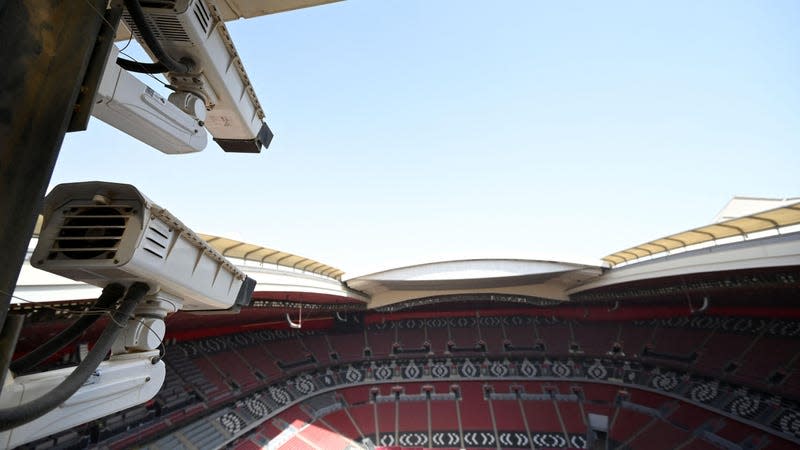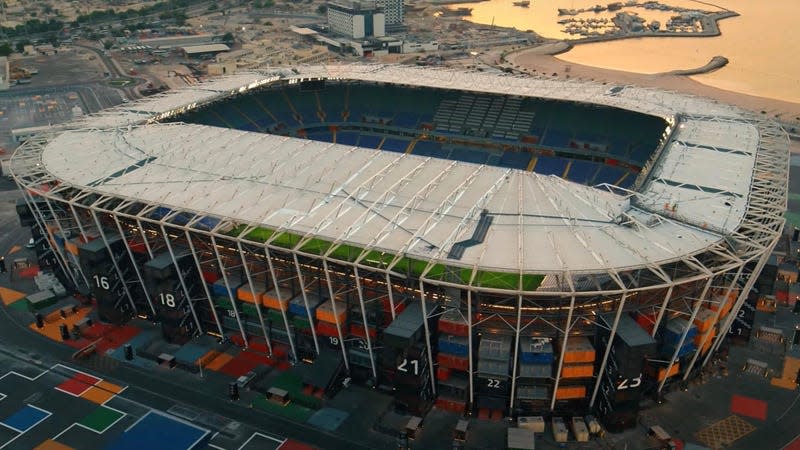Here's How Tech Is Shaping the 2022 FIFA World Cup

The 2022 World Cup in Qatar is the first of many things: the first World Cup held in the Winter, the first held in Gulf Arab state, and the first to use a whole suit of new tracking technologies vying to modernize soccer’s traditionalist culture. Like most incremental changes in sports, not all fans are onboard.
Like it or not though, Qatar, which has reportedly spent over $300 billion building out infrastructure for the tournament since it was first awarded rights to the event 12 years ago, is using the opportunity to flaunt some of its glitziest, and in some cases scariest, high tech solutions. Here are some of ways tech is impacting this year’s FIFA World Cup.
Read more
Motion Tracking Soccer Balls

Each soccer ball used during this year’s World Cup will feature “connected ball technology” developed by Adidas, which the sporting giant says should provide precise data tracking on the impact and movement of every kick and header on the pitch. Though the ball might look normal on the outside, internally it’s equipped with a motion sensor powered by a rechargeable battery. That motion sensor sends data to FIFA’s Video Match Officials who then review the data live to help determine offside decisions and resolve disputes over unclear touches.
But don’t expect to see the sensor ball on store shelves anytime soon. For now, Adidas said, The Official Match ball is exclusive to FIFA and won’t be commercialized.
Semi-Automated Offside Tracking

The motion sensor equipped ball represents just one data point in the semi-automated offside tracking technology intended to cut down on the amount of stoppage time for review. To determine whether or not players are offside, FIFA deploys 12 cameras underneath stadiums’ roofs to track both the ball and up to 29 data points on individual players. (For anyone who needs a refresher, players in soccer are determined offside if they are closer to the goal than the ball and the furthest back defender while they are attacking.) FIFA says its cameras measure these data points up to 50 times per second.
“By combining the limb-and ball-tracking data and applying artificial intelligence, the new technology provides an automated offside alert to the video match officials inside the video operation room whenever the ball is received by an attacker who was in an offside position at the moment the ball was played by a team-mate,” FIFA wrote in a blog post.
But here’s where things get a little spooky. Once a referee confirms an offside decision, the automated system then generates a 3D animation that, “perfectly details the position of the players’ limbs at the moment the ball was played,” and places that image on the giant screens in a stadium for all of the audience to see.
Cameras and Facial Recognition

On the creepier side of things, this year’s World Cup will also go down as one of the most tightly surveilled in the sport’s history. This year, each and every attendee entering a stadium will be tracked by a system of 15,000 cameras equipped with facial recognition technology. The surveillance apparatus, reminiscent of the tech used by more notorious Clearview AI, is reportedly controlled through a technical hub called the Aspire command and control center. That command center will seat a row of technicians monitoring and analyzing those camera feeds.
The surveillance system expands past stadium confines and will also include nearby train and bus stations. Overheard, drones will reportedly fly overhead to estimate crowd size.
“What you see here is a new standard, a new trend in venue operations, this is our contribution from Qatar to the world of sport,” Niyas Abdulrahiman, the event’s chief technology office, said in an interview with AFP. “What you see here is the future of stadium operations.”
Fifa Player App

In addition to all the cameras and sensors tracking players real time movements, players themselves can track their own details like never before with the new FIFA Player App. The new app monitors a players’ game time performance and then provides specific, player-tailored insights shortly after a match concludes.
The app measures a variety of data points captured by on field cameras, including distance covered, maximum speeds and number of actions performed above a certain speed threshold. Using those metrics and other signs of player’s performance, an algorithm then translates that into analysis and insights footballers can study. All of that data, according to FIFA, is synchronized with actual match footage so a player can go back and see how they performed in key moments.
World’s First Collapsible Stadium

Qatar has reportedly spent well over $300 billion on infrastructure and new stadiums for the 2022 World Cup since it was awarded rights to the event. Part of those funds went towards crafting Stadium 974, an odd monstrosity created entirely of shipping containers and modular steel. World Cup organizers, according to MarketWatch, have billed 974 as, “the first fully demountable covered football stadium.”
Though it’s unclear where exactly 974 will end up once the games conclude some reports speculate it could make its way to Uruguay if it wins its bid to host the 2030 World Cup.
Sustainable(ish) Cooling Systems

One of the most significant concerns surrounding the Qatari games since they first announced impacts both players and fans alike: heat. In an unprecedented move, FIFA, which has always held the World Cup in the Summer season, moved the event’s start date to account for the Gulf State’s sweltering heat. Even towards the end of November, however, temperatures in the capital city of Doha are expected to approach 90 degrees fahrenheit.
To compensate with those temperatures, stadiums will rely on a new cooling system designed by Qatari professor Saud Abdulaziz Abdul Ghan (also known as “Dr.Cool”) which works by cooling outside air that flows into the stadium through pipes which is then expelled through grills in the stands and nozzles by the field. The cooling system, which FIFA claims was intentionally designed with sustainability in mind, is powered by solar energy.
Officials reportedly use sensors to monitor temperature fluctuation from a command center and can adjust them when needed.
More from Gizmodo
The Best Shortcuts On Mac: Snap Windows, Text to Speech, and More
How to Delete Your Twitter Account If Elon Musk Was Your Last Straw
Sign up for Gizmodo's Newsletter. For the latest news, Facebook, Twitter and Instagram.

